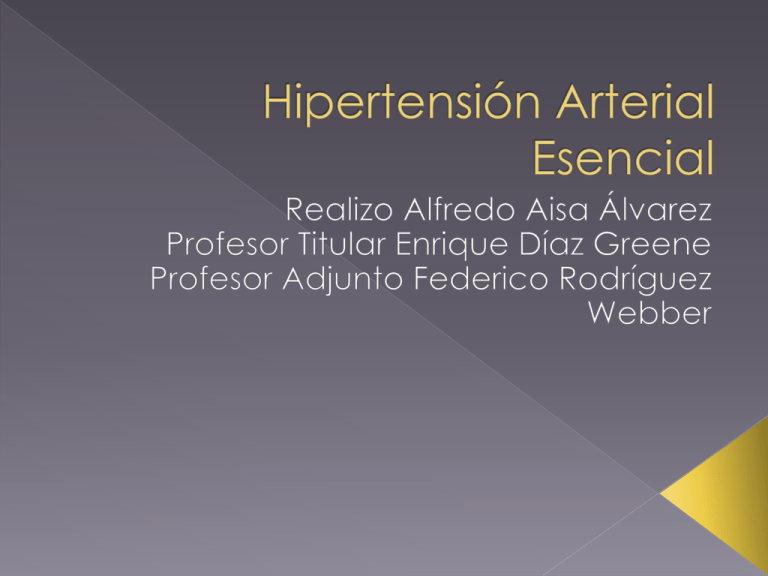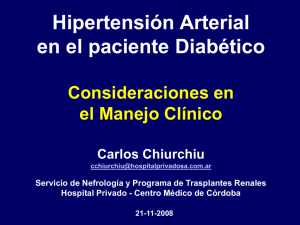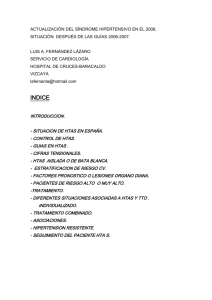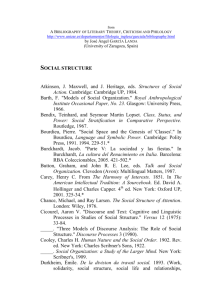Hipertensión Arterial Esencial
advertisement

En México en el año 2000 prevalencia 30.05% (20 y 69 años) 15,000 Mexicanos 43.2% HAS (Salud Publica de México 2010) EUA 1999-2000 29-31% >18 años 58-65 millones personas EU Hypertension in Mexican adults: results from the National Health and Nutrition Survey 2006. Salud Pública Méx 2010; Vol. 52(sup 1):63-71 Presión arterial > 140/90 JNC VII (2003) Dos o Mas tomas de manera apropiada › Presión arterial Normal: Sistólica < 120 mmHg Diastólica < 90 mmHg › Pre hipertensión: Sistólica 120 – 139 mmHg Diastólica 80 – 89 mmHg › Hipertensión: Estadio I: Sistólica 140 – 159 mmHg Diastólica 90 – 99 mmHg Estadio II: Sistólica ≥ 160 mmHg Diastólica ≥ 100 mmHg Chobanian AV, Bakris GL, Black HR, et al. The Seventh Report of the Joint National Committee on Prevention, Detection, Evaluation, and Treatment of High Blood Pressure: the JNC 7 report. JAMA 2003; 289:2560. Hipertensión sistólica aislada: › Presión arterial >140/<90 Hipertensión diastólica aislada: › Presión arterial <140/>90 La presión arterial sistólica es el mayor predictor de riesgo en mayores 50 – 60 años Franklin SS, Larson MG, Khan SA, et al. Does the relation of blood pressure to coronary heart disease risk change with aging? The Framingham Heart Study. Circulation 2001; 103:1245. European Societies of Hypertension and Cardiology (2007): › Presión arterial optima: Sistólica <120 mmHg Diastólica <80 mmHg › Normal: sistólica 120-129 mmHg y/o diastólica 80-84 mmHg › Normal Alta: Sistólica 130-139 mmHg y/o Diastólica 85-89 mmHg › Hipertensión: Grado 1: Sistólica 140-159 mmHg y/o Diastólica 90-99 mmHg Grado 2: Sistólica 160-179 mmHg y/o Diastólica 100-109 mmHg Grado 3: Sistólica ≥180 mmHg y/o Diastólica ≥110 mmHg Hipertensión sistólica aislada: Sistólica ≥140 mmHg y diastólica <90 mmHg Mancia G, De Backer G, Dominiczak A, et al. 2007 Guidelines for the Management of Arterial Hypertension: The Task Force for the Management of Arterial Hypertension of the European Society of Hypertension (ESH) and of the European Society of Cardiology (ESC). J Hypertens 2007; 25:1105. Hipertensión Arterial Maligna › Hemorragia retiniana, exudados o papiledema › Normalmente asociada a TAD >120 mmHg › TAD <100 mmHg asociada a preclampsia GMN Urgencia Hipertensiva › TAD >120 mmHg sin síntomas Severe symptomless hypertension. Lancet 1989; 2:1369 Raza Negra Factores genéticos (Padre, Madre o Ambos) Ingesta de Sal ??? (Causa Necesaria no Suficiente) Consumo alcohol Obesidad Sedentarismo Dislipidemia Consumo de bebidas endulzadas con fructuosa??? Rasgos de personalidad de Simone G, Devereux RB, Chinali M, et al. Risk factors for arterial hypertension in adults with initial optimal blood pressure: the Strong Heart Study. Hypertension 2006; 47:162. > Riesgo de ECV prematura. En personas Mayores > riesgo PAS Hipertrofia del ventrículo izquierdo › Falla cardiaca › Arritmias › Muerte secundaria a infarto › Muerte súbita Factor de riesgo mas importante EVC Wilson PW. Established risk factors and coronary artery disease: the Framingham Study. Am J Hypertens 1994; 7:7S Factor de riesgo mas importante de hemorragia intracerebral Factor de riesgo de insuficiencia renal crónica e insuficiencia renal terminal: Nefroesclerosis Elevación aguda puede poner riesgo la vida Hsu CY, McCulloch CE, Darbinian J, et al. Elevated blood pressure and risk of end-stage renal disease in subjects without baseline kidney disease. Arch Intern Med 2005; 165:923 Escrutinio › USPSTF cada 2 años < 120/80 y anualmente TA 120-139/80-89 U.S. Preventive Services Task Force. Screening for high blood pressure: U.S. Preventive Services Task Force reaffirmation recommendation statement. Ann Intern Med 2007; 147:783. Síndrome de bata blanca Sospecha de hipertensión episódica (Feocromocitoma) Hipertensión resistente a tratamiento Síntomas hipotensión durante tratamiento antihipertensivo Disfunción autonómica O'Brien E, Asmar R, Beilin L, et al. Practice guidelines of the European Society of Hypertension for clinic, ambulatory and self blood pressure measurement. J Hypertens 2005; 23:697. Objetivos › Determinar la extensión daño órgano blanco › Establecer el riesgo cardiovascular › Identificar causas reversibles de hipertensión BHC EGO QS (Glucosa, Cr) ES Estimar TFG Perfil de lípidos Electrocardiograma Proteínas en orina (DM2) Ecocardiograma Forman JP, Brenner BM. 'Hypertension' and 'microalbuminuria': the bell tolls for thee. Kidney Int 2006; 69:22. Obtener la máxima reducción de PA para obtener la máxima reducción del riesgo CV. La PA debe reducirse < 140/90 mmHg y lo mínimo tolerable en todos los pacientes hipertensos y lo min PA <130/80 en Diabéticos, EVC, Infarto, IR, Proteinuria Debe iniciarse tratamiento antes de daño CV Pre hipertensión (120-139/80-89) requiere cambios en el estilo de vida Hipertensión no complicada se debe utilizar una Tiazida sola o en combinación con otro fármaco En condiciones alto riesgo tratamiento especifico DM 2, IRC: 2 fármacos para mantener TA <140/90 o <130/80 Pacientes con 20 mmHg > objetivo TAS o > 10 mmHg del objetivo TAD: Utilizar 2 fármacos considerando una tiazida Disminución de la ingesta de sal Disminución de peso en pacientes obesos Disminución del consumo de Alcohol Ejercicio Aeróbico Regular Chobanian AV, Bakris GL, Black HR, et al. The Seventh Report of the Joint National Committee on Prevention, Detection, Evaluation, and Treatment of High Blood Pressure: the JNC 7 report. JAMA 2003; 289:2560. Chobanian AV, Bakris GL, Black HR, et al. The Seventh Report of the Joint National Committee on Prevention, Detection, Evaluation, and Treatment of High Blood Pressure: the JNC 7 report. JAMA 2003; 289:2560. Hipertensión en sociedades con consumo < 50 meq/dia es rara (1.2 gr Sodio) Mas frecuente en sociedades con consumo > 100 meq/dia (2.3 gr Sodio) La ingesta 50-100 meq/dia Na es necesaria pero no suficiente para desarrollar hipertensión. Dietas bajas en potasio aumentan la reabsorción de sodio. Adrogué HJ, Madias NE. Sodium and potassium in the pathogenesis of hypertension. N Engl J Med 2007; 356:1966. JNC VII recomienda consumir <100 meq/dia (< 2.3 gr sodio o < 6 gr cloruro de sodio). La Sociedad Europea de Hipertensión recomienda < 85 meq/dia (2 gr sodio) Efecto secundario: Dieta < 20 meq/dia puede elevar 10% niveles LDL Mancia G, De Backer G, Dominiczak A, et al. 2007 Guidelines for the Management of Arterial Hypertension: The Task Force for the Management of Arterial Hypertension of the European Society of Hypertension (ESH) and of the European Society of Cardiology (ESC). J Hypertens 2007; 25:1105. Puede significar una disminución importante de la presión arterial Aproximadamente 0.5 a 2 mmHg por cada kg de perdida Chobanian AV, Bakris GL, Black HR, et al. The Seventh Report of the Joint National Committee on Prevention, Detection, Evaluation, and Treatment of High Blood Pressure: the JNC 7 report. JAMA 2003; 289:2560. TOMHS Study (Treatment Of Mild Hypertension Study) › 902 paciente con hipertensión moderada (90 a 100 mmHg) › Disminución peso, restricción de sodio y alcohol y aumento de la actividad física › Disminución 8.6/8.6 mmHg en la presión arterial a los 4 años › < Riesgo cardiovascular por < Colesterol LDL y > HDL Neaton JD, Grimm RH Jr, Prineas RJ, et al. Treatment of Mild Hypertension Study. Final results. Treatment of Mild Hypertension Study Research Group. JAMA 1993; 270:713 DASH Trial: › 459 pacientes con TA 160/80-95 mmHg › DASH Dieta rica en frutas y verduras, baja en grasas saturadas › Disminución de 5.5/3.0mm Hg presión arterial › Los efectos fueron máximos al final de la semana 2 Sacks FM, Svetkey LP, Vollmer WM, et al. Effects on blood pressure of reduced dietary sodium and the Dietary Approaches to Stop Hypertension (DASH) diet. DASH-Sodium Collaborative Research Group. N Engl J Med 2001; 344:3. DASH Baja en Sodio › 412 pacientes dieta DASH mas 3 niveles consumo de sodio (3.5, 2.3 y 1.2 g)por 30 días › Dieta DASH disminuyo TAS en comparación con control › Con ingesta sodio 3.5, 2.3 y 1.2 g disminuyo 5.9, 5 y 2 mmHg la presión arterial respectivamente › Mayor efecto en grupo DASH con dieta baja en sodio (8.9 mmHg TAS y 4.5 mmHg TAD) Sacks FM, Svetkey LP, Vollmer WM, et al. Effects on blood pressure of reduced dietary sodium and the Dietary Approaches to Stop Hypertension (DASH) diet. DASH-Sodium Collaborative Research Group. N Engl J Med 2001; 344:3. Estudio PREMIER › 810 pacientes asignados de manea aleatoria en 3 grupos › 1) Cambios en el estilo vida › 2) DASH mas cambios en el estilo vida › 3)Asesoramiento en una ocasión › Grupo 2 mayor disminución TA en comparación con grupo 1 (4.3/2.6 mmHg 3.7/1.7 mmHg respectivamente) › Grupo 1 y 2 superior a grupo 3 Elmer PJ, Obarzanek E, Vollmer WM, et al. Effects of comprehensive lifestyle modification on diet, weight, physical fitness, and blood pressure control: 18-month results of a randomized trial. Ann Intern Med 2006; 144:485. Mujeres que consumen dos o mas bebidas alcohólicas por día y hombres que consumen tres o mas bebidas alcohólicas tienen un aumento significativo en la presión arterial Dependiente de dosis Mas prominente cuando se toman > 5 bebidas Forman JP, Stampfer MJ, Curhan GC. Diet and lifestyle risk factors associated with incident hypertension in women. JAMA 2009; 302:401. Cinco clases de antihipertensivos: Diuréticos Tiazidicos, Calcioantagonistas, IECAS, B Bloqueadores, ARA II. B Bloqueadores, especialmente en combinación con tiazidas no deben usarse en pacientes con Sx. Metabólico o riesgo de DM II. En la mayoría es necesario > 1 fármaco Mancia G, De Backer G, Dominiczak A, et al. 2007 Guidelines for the Management of Arterial Hypertension: The Task Force for the Management of Arterial Hypertension of the European Society of Hypertension (ESH) and of the European Society of Cardiology (ESC). J Hypertens 2007; 25:1105. En la elección debe considerarse lo siguiente: › Experiencias del paciente con el fármaco › Los efectos en el riesgo CV › Presencia de daño subclínico a algún órgano, IR, DM o enfermedad CV. › Enfermedades que contraindiquen algún fármaco › Interacciones entre fármacos › Costo Mancia G, De Backer G, Dominiczak A, et al. 2007 Guidelines for the Management of Arterial Hypertension: The Task Force for the Management of Arterial Hypertension of the European Society of Hypertension (ESH) and of the European Society of Cardiology (ESC). J Hypertens 2007; 25:1105. Chobanian AV, Bakris GL, Black HR, et al. The Seventh Report of the Joint National Committee on Prevention, Detection, Evaluation, and Treatment of High Blood Pressure: the JNC 7 report. JAMA 2003; 289:2560. Mancia G, De Backer G, Dominiczak A, et al. 2007 Guidelines for the Management of Arterial Hypertension: The Task Force for the Management of Arterial Hypertension of the European Society of Hypertension (ESH) and of the European Society of Cardiology (ESC). J Hypertens 2007; 25:1105. Mancia G, De Backer G, Dominiczak A, et al. 2007 Guidelines for the Management of Arterial Hypertension: The Task Force for the Management of Arterial Hypertension of the European Society of Hypertension (ESH) and of the European Society of Cardiology (ESC). J Hypertens 2007; 25:1105. Mancia G, De Backer G, Dominiczak A, et al. 2007 Guidelines for the Management of Arterial Hypertension: The Task Force for the Management of Arterial Hypertension of the European Society of Hypertension (ESH) and of the European Society of Cardiology (ESC). J Hypertens 2007; 25:1105. Monoterapia controla la PA en un numero limitado de pacientes Utilización de terapia combinada es necesaria en la mayoría de los pacientes Se puede iniciar con monoterapia o terapia combinada según se requiera Monoterapia: Tratamiento inicial con HTA moderada y bajos o moderados factores de riesgo CV. Mancia G, De Backer G, Dominiczak A, et al. 2007 Guidelines for the Management of Arterial Hypertension: The Task Force for the Management of Arterial Hypertension of the European Society of Hypertension (ESH) and of the European Society of Cardiology (ESC). J Hypertens 2007; 25:1105. Terapia 2 fármacos en pacientes con estadios II, III ESHC o II JNC VII con alto riesgo CV Si no son efectivos 2 fármacos en el control de PA se pueden utilizar 3 Mancia G, De Backer G, Dominiczak A, et al. 2007 Guidelines for the Management of Arterial Hypertension: The Task Force for the Management of Arterial Hypertension of the European Society of Hypertension (ESH) and of the European Society of Cardiology (ESC). J Hypertens 2007; 25:1105. Mancia G, De Backer G, Dominiczak A, et al. 2007 Guidelines for the Management of Arterial Hypertension: The Task Force for the Management of Arterial Hypertension of the European Society of Hypertension (ESH) and of the European Society of Cardiology (ESC). J Hypertens 2007; 25:1105.





